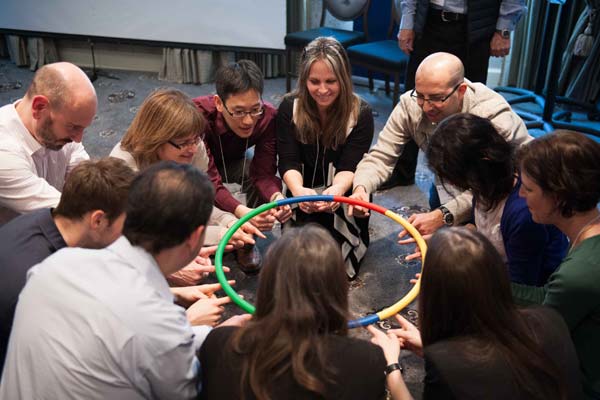
Turning top researchers into science's cultural ambassadors with U of T's Science Engagement
Published: April 29, 2014
Working as a team to lower a hula hoop to the ground using only two fingers apiece can be quite a challenge, as 21 science faculty members from the University of Toronto and other Canadian universities learned during the Science Leadership Program last week.
Laughter echoed off the walls during this teamwork activity, one of the many sessions comprising the Science Leadership Program, a two-day ‘boot camp’ for a select group of academic researchers that is designed to improve their leadership and communications skills.
The innovative program is the brainchild of Professor Ray Jayawardhana, senior advisor on science engagement to the U of T president. It draws upon elements from a number of initiatives, including Stanford University’s Leopold Leadership Program for environmental scientists, as well as Jayawardhana’s own vision. Now in its second year, the Science Leadership Program is sponsored by Science Engagement at U of T and the Connaught Fund.
“This is an idea that developed over a few years,” said Jayawardhana. “It comes from my own experience working with the media and doing public outreach, plus a sense that many of my colleagues are keen to engage more effectively beyond academia.
“For some accomplished researchers, even if they have the inclination and interest, they may not know how best to go about it. This is a chance for them to enhance their skills and networks and to be inspired and energized by like-minded colleagues.”
The U of T president, Meric Gertler, welcomed the researchers during an opening reception at Hart House.
“Our culture has embraced passionate argument without evidence and favours ersatz controversy over intellectual merit,” Gertler told the scientists. “Science literacy is the antidote to all of this, and this is where you play a vital role.”
The program’s first day offered workshops on presentation skills, mind and network mapping and achieving change. The morning began with a series of theatre exercises directed by Nancy Houfek, a voice instructor at the American Repertory Theatre at Harvard University and an acting coach for numerous Broadway productions. She had the researchers dancing the Hokey Pokey and tossing sponge balls in order to loosen up and connect with an audience, then practising positioning, delivery and narrative.
Andrea Gershon, a physician at Sunnybrook Health Sciences Centre, who also works for the Institute for Clinical and Evaluative Studies, in addition to her Faculty of Medicine appointment, was one of the many participants who found the presentation exercises very helpful.
“As a scientist, performance is something we’re not taught and are taught not to value it, because it’s the arts,” Gershon said. “I’m giving three talks in the next couple of weeks and I plan to apply what I learned.”
The following day, the program’s focus turned to using social media, working with traditional media, engaging with government officials and action planning. Panels of experts, including experienced scientists, bloggers, reporters, and university government relations staff, shared their perspectives with the participants and encouraged them to talk about their research with the public and policy makers.
Janet Mason, the Assistant Deputy Minister of Municipal Affairs and Housing for Ontario, urged the scientists to develop an understanding of the point of view of elected officials so their proposals for research funding would align with government objectives. Meanwhile, Rob Esselment, senior director of government affairs at the University of Waterloo, encouraged the scientists to get to know their government relations officers so they would have more stories to use when explaining the value and impact of their research to elected officials.
The program activities ended with each researcher sharing plans for using their new skills to accomplish one new action within a week and another within a month. Keeping in touch with their new cohort was a plan that cropped up more than once. At the closing dinner, Washington Post reporter Joel Achenbach enlightened and entertained the group with his adventures in covering science.
“It was nice as a faculty member to interact with individuals doing research across different areas,” said Julie McCarthy, an associate professor of management who is the acting vice-president of research at U of T Scarborough. “It was invigorating to learn about their goals and research. This is an incredible group of individuals.”
Jayawardhana was delighted by the researchers’ palpable enthusiasm for the program.
“We’re reinforcing skills and enhancing networks,” he said. “Over 10 years, we’ll have a group of more than 200 very engaged scientists working at many levels, bringing an awareness of science to the public and connecting with opinion shapers and decision makers. Ultimately, I hope, these scientists will help foster a culture change.”



